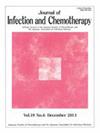Isepamicin alone as antimicrobial prophylaxis for transrectal prostate needle biopsy: “Do we still need levofloxacin? ”
IF 1.9
4区 医学
Q3 INFECTIOUS DISEASES
引用次数: 0
Abstract
The purpose of this study was to investigate whether conventional levofloxacin (LVFX) administration is unnecessary for transrectal ultrasound-guided prostate needle biopsy (TRP-Bx) in view of the increase in LVFX-resistant Escherichia coli and appropriate use of antibiotics. The study included 636 cases undergoing TRP-Bx, divided into two groups based on the prophylactic antibiotic regimen. Group 1 (n = 308) received both oral levofloxacin (LVFX) 500 mg and intravenous isepamicin (ISP) 400 mg. Group 2 (n = 328) received only intravenous ISP 400 mg. Biopsies involved sampling 12 cores using an 18G needle. A high-risk subgroup included patients with a large prostate (>75 ml), severe dysuria, diabetes mellitus, or steroid use. Significantly more high-risk cases were in Group 2 than in Group 1 (35.7 % vs. 24.4 %, p = 0.003). Febrile genitourinary tract infections (fGUTIs) occurred in three patients (0.5 %), with no significant difference between the groups (0.3 % in Group 1 vs. 0.6 % in Group 2). No fGUTI complications were noted among high-risk cases in either group. Of the fGUTI cases, one involved LVFX-resistant E. coli; another involved E. coli susceptible to both LVFX and amikacin, isolated from blood. The single- and short-duration intravenous dose of ISP 400 mg would appear to be one of possible options in preventing TRP-Bx-related fGUTIs in both low-risk and high-risk patients.
经直肠前列腺穿刺活检:“我们还需要左氧氟沙星吗?”".
鉴于左氧氟沙星(LVFX)耐药大肠杆菌的增加和抗生素的适当使用,本研究的目的是探讨在经直肠超声引导前列腺穿刺活检(TRP-Bx)中是否需要传统的左氧氟沙星(LVFX)。本研究纳入636例接受TRP-Bx治疗的患者,根据预防性抗生素方案分为两组。1组308例患者口服左氧氟沙星(LVFX) 500 mg,静脉注射异帕霉素(ISP) 400 mg。第2组(328例)仅静脉注射ISP 400mg。活组织检查包括使用18G针取样12个核。高危亚组包括前列腺肥大(前列腺肥大75毫升)、严重排尿困难、糖尿病或使用类固醇的患者。2组高危病例明显多于1组(35.7% vs. 24.4%, p = 0.003)。3例患者(0.5%)发生发热性泌尿生殖系统感染(fGUTIs),两组间无显著差异(1组为0.3%,2组为0.6%)。两组高危病例均未发现fGUTI并发症。在fGUTI病例中,1例涉及对lvfx耐药的大肠杆菌;另一项研究涉及从血液中分离出的对LVFX和阿米卡星都敏感的大肠杆菌。单次和短时间静脉注射isp400mg似乎是预防低风险和高风险患者trp - bx相关fGUTIs的可能选择之一。
本文章由计算机程序翻译,如有差异,请以英文原文为准。
求助全文
约1分钟内获得全文
求助全文
来源期刊

Journal of Infection and Chemotherapy
INFECTIOUS DISEASES-PHARMACOLOGY & PHARMACY
CiteScore
4.10
自引率
4.50%
发文量
303
审稿时长
47 days
期刊介绍:
The Journal of Infection and Chemotherapy (JIC) — official journal of the Japanese Society of Chemotherapy and The Japanese Association for Infectious Diseases — welcomes original papers, laboratory or clinical, as well as case reports, notes, committee reports, surveillance and guidelines from all parts of the world on all aspects of chemotherapy, covering the pathogenesis, diagnosis, treatment, and control of infection, including treatment with anticancer drugs. Experimental studies on animal models and pharmacokinetics, and reports on epidemiology and clinical trials are particularly welcome.
 求助内容:
求助内容: 应助结果提醒方式:
应助结果提醒方式:


